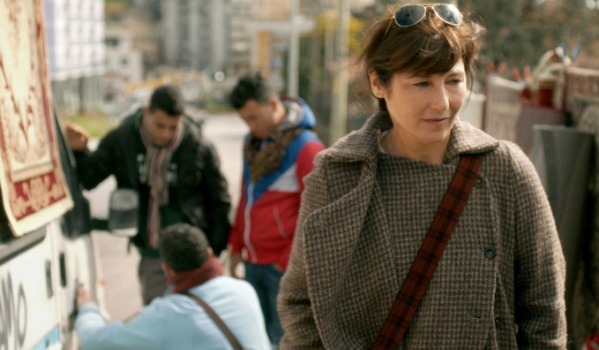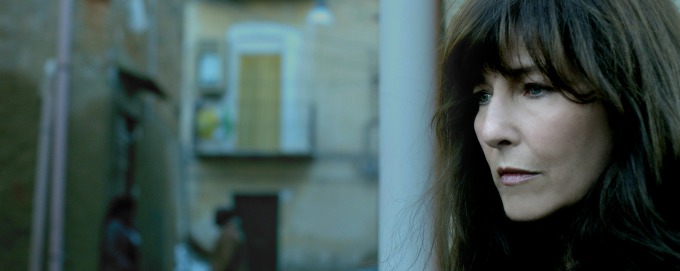Late on a Sunday evening was the ideal time to watch the UK premiere of this contemplative, moody piece by Mark Jackson, starring Catherine Keener as Lee, a traumatised American photo-journalist. This tough, resilient woman, used to working in war zones, seems crushed by recent events, and has escaped to Sicily to lick her wounds. She has recently emerged from an attack on her and her colleague, who was then brutally killed. Lee is still severely bruised from a beating. WAR STORY follows the first steps on a journey of recovery and redemption. She is usually the recorder of war stories – now she is the subject.
Much of the slowly-unfurling action occurs in a claustrophobic hotel room in Sicily. When she checks in she asks for the same room she’d stayed in some time ago – perhaps a hint at something deeper than a professional relationship with her murdered colleague. Her room is a sanctuary that Lee can control, and in which she can isolate herself. Her emotions are raw. She can’t bear to answer the phone or speak to any of her friends. She doesn’t seem to like comfort, preferring to shift the mattress onto the floor and making a barricade that is safe to sleep in. Perhaps she had been held hostage. Jackson hints at much, but reveals slowly – sometimes not at all.
“WAR STORY’s ambient sound-scape is jagged and unsettling, the colour palette restrained and cool..”
Even when outside Lee is solitary and defensive, except when she’s talking to some young men – illegal immigrants or asylum seekers from North Africa. She seems at ease with these people who have nowhere to call home. On a walk into town, Lee photographs what looks like an internment camp. The police make her delete the photos she’s taken. It all adds to a growing sense of insecurity that Lee can’t shake off. She’s a prickly woman, intolerant of others until she meets Hafsia (Hafsia Herzi), a young Tunisian migrant. This young woman reminds her of a girl she had once photographed in war-torn Libya. A connection is made, and it is Hafsia who eventually gives Lee the key to returning to the world. She, too, has been in danger, having recently fled from Tunisia in an overloaded boat. Her brother was lost at sea and she is pregnant, and urgently needs an abortion. Lee takes Hafsia under her wing, and a more caring side emerges, stopping at nothing to help this vulnerable girl. In the end Hafsia is not so helpless. Her determination to make a new independent life for herself seems to give Lee the kick she needs to resume living in the real world.
Perhaps the least successful element of an engrossing narrative is a visit to her old boss (and ex-lover?), played by Ben Kingsley. The only real purpose of this meeting, apart from picking up a car, seems to be to remind the viewer of Lee’s mental turmoil. He tells her loudly she’s crazy, but we, and Lee, know that already.
WAR STORY’s ambient sound-scape is jagged and unsettling, the colour palette restrained and cool. Both underscore Lee’s frozen emotional state. There is little to suggest warmth here, until Hafsia enters the picture, and warm browns and golds start to appear. The camera is either uncomfortably close to a character’s face, or remains at a distance, perched in the corner of a room looking in, or sitting beside Lee looking at her profile in close up. WAR STORY makes a strong point about the impact of conflict on both civilians and those who work in battle areas. Both these women have been severely tested in the worst of circumstances, but their fleeting friendship helps them both to move on to the next stage. It’s hard to avoid the conclusion, however, that Hafsia will succeed whereas the outcome for Lee is much more fragile.
httpvh://youtu.be/xmjyp1BMTtc



One thought on “War Story”
Comments are closed.